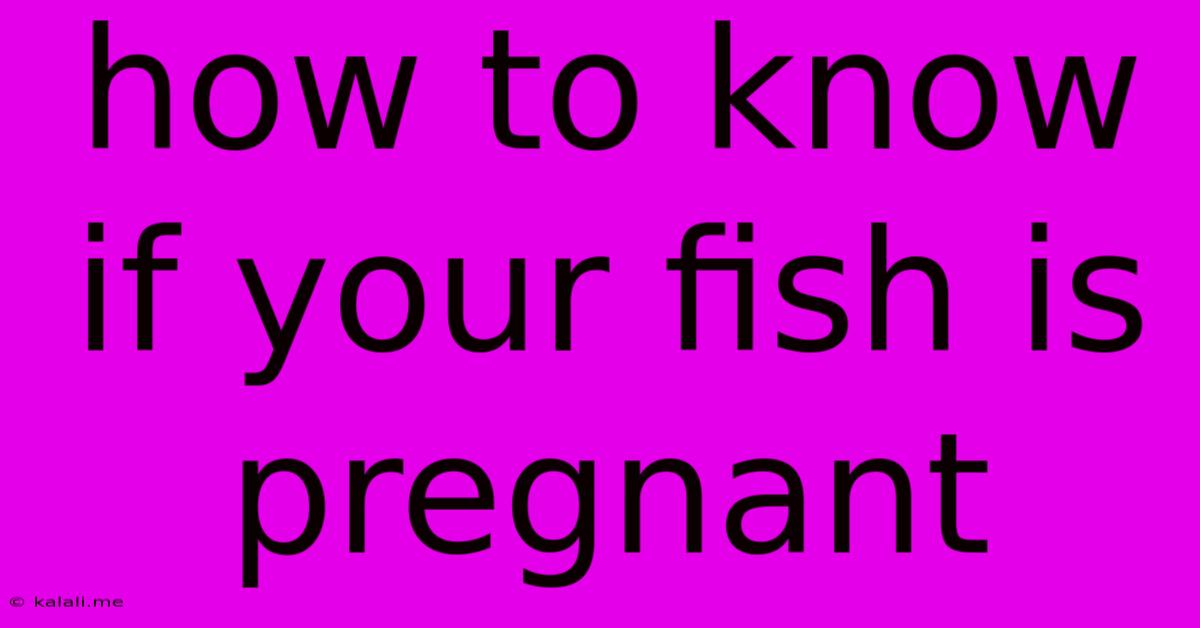How To Know If Your Fish Is Pregnant
Kalali
Jun 05, 2025 · 3 min read

Table of Contents
How to Know if Your Fish is Pregnant: A Comprehensive Guide
Knowing whether your fish is pregnant can be incredibly exciting, but it's not always easy to tell. Many fish species exhibit subtle changes in behavior and appearance during pregnancy. This guide will help you understand the signs and symptoms of pregnancy in various fish types, providing you with the knowledge to care for your expectant mother and her future fry. This article covers common indicators, species-specific differences, and important considerations for ensuring a healthy pregnancy and successful birth.
Understanding Fish Reproduction: A Quick Overview
Before diving into the signs of pregnancy, it's essential to understand the basics of fish reproduction. Unlike mammals, fish reproduction varies greatly depending on the species. Some are ovoviviparous, meaning they carry eggs internally that hatch inside the mother, while others are viviparous, giving birth to live young. Still others are oviparous, laying eggs externally for fertilization. The methods of identifying pregnancy differ accordingly.
Common Signs of Pregnancy in Fish
While not all signs apply to every species, here are some general indicators that your fish might be pregnant:
-
Distended Abdomen: One of the most obvious signs is a noticeably swollen abdomen. This is especially apparent in livebearing fish like guppies, mollies, and platies. The abdomen will become significantly rounder and fuller than usual. However, be cautious; a bloated belly can also indicate other health problems.
-
Increased Appetite: Pregnant fish often experience an increased appetite to provide enough energy for themselves and developing eggs or embryos. This increased food intake is especially noticeable in the later stages of pregnancy.
-
Behavioral Changes: Pregnant fish might exhibit altered behavior. They may become more lethargic, shy, or hide more frequently. Some might even become more aggressive towards tank mates.
-
Gravid Spot: Certain species, such as some livebearers, develop a dark spot near the anal fin called a gravid spot. This spot becomes more pronounced as pregnancy progresses.
-
Body Shape Changes: In addition to a swollen abdomen, the overall body shape might change, appearing more rounded and less streamlined.
-
Drooping Belly: In the final stages of pregnancy, the belly may appear to droop noticeably, almost touching the substrate.
Species-Specific Considerations:
The signs of pregnancy vary between fish species. For example:
-
Livebearers (Guppies, Mollies, Platies, Swordtails): These fish are easier to identify as pregnant due to the visibly enlarged abdomen and gravid spot.
-
Egg-layers (Betta, Discus, Cichlids): Identifying pregnancy in egg-laying fish is much more difficult and often only apparent shortly before spawning. You might observe them selecting a nesting site or exhibiting breeding behaviors such as chasing and nest building.
-
Ovoviviparous fish (some sharks and rays): These fish retain fertilized eggs within their bodies until they hatch. Similar to livebearers, an enlarged abdomen is the most prominent sign, however this can sometimes take several months to become apparent.
Differentiating Pregnancy from Other Conditions:
It's crucial to differentiate pregnancy from other health issues that might cause abdominal swelling, such as:
-
Dropsy: A serious bacterial or parasitic infection that causes fluid buildup in the abdomen. Dropsy is often accompanied by other symptoms like pineconing (scales sticking out), lethargy, and loss of appetite.
-
Constipation: Constipation can also lead to a bloated belly. Observe your fish's bowel movements; if they're infrequent or difficult to pass, this could be the cause.
Preparing for Fry:
Once you've confirmed your fish is pregnant, preparing for the arrival of the fry is essential. This includes:
-
Providing a suitable breeding environment: This may involve a separate breeding tank to protect the fry from being eaten by their parents or tank mates.
-
Ensuring good water quality: Maintaining pristine water conditions is crucial for a healthy pregnancy and the survival of the fry.
-
Providing appropriate nutrition: Continue to provide high-quality food to support the mother's energy needs.
By carefully observing your fish and understanding the specific signs of pregnancy for your species, you can ensure a healthy pregnancy and a successful birth. Remember to consult reliable sources and experienced fish keepers if you have any concerns.
Latest Posts
Latest Posts
-
How To Redeem Gta 5 Premium Edition On Pc
Jun 06, 2025
-
Which Word Is A Antonym For The Word Euphoria
Jun 06, 2025
-
Can I Travel With An Expired Id
Jun 06, 2025
-
Round To The Three Decimal Places
Jun 06, 2025
-
Are You Supposed To Read The Hobbit First
Jun 06, 2025
Related Post
Thank you for visiting our website which covers about How To Know If Your Fish Is Pregnant . We hope the information provided has been useful to you. Feel free to contact us if you have any questions or need further assistance. See you next time and don't miss to bookmark.